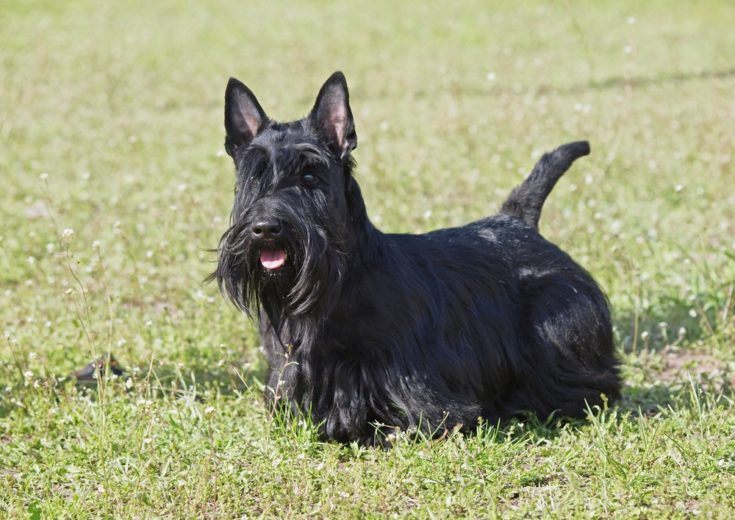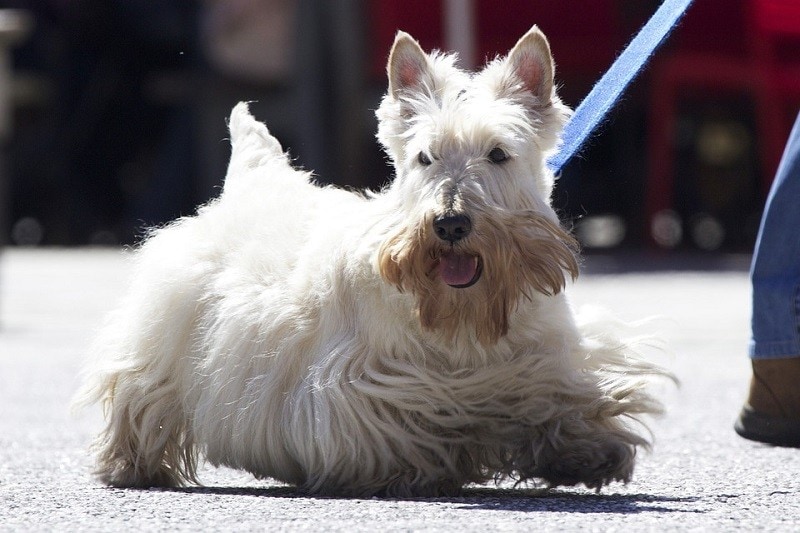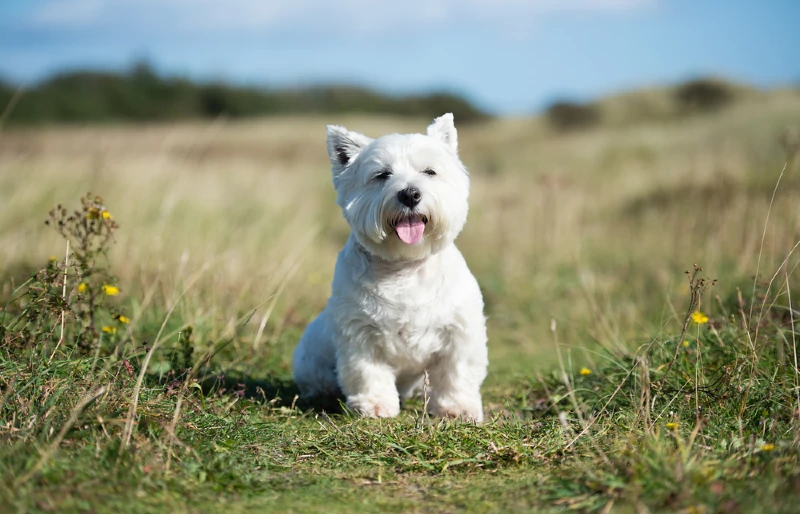Scottish Terrier vs Westie: Main Differences (With Pictures)

Updated on

Click to Skip Ahead
The Scottish Terrier and West Highland White Terrier are purebred dogs that belong to the terrier group. Both are Scotland natives and are known for their bright and confident personalities. Though they’re both on the smaller side, they have big personalities and often add more fun and excitement to people’s lives.
While they share many similarities, Scottish Terriers and Westies also have many more differences other than their coat colors. Getting to know each breed’s temperament and unique care needs will help you determine which one is a better fit for you. Keep reading to get to know each breed and what daily life with each of them could look like.
Visual Differences

At a Glance
- Average height (adult): 9–11 inches
- Average weight (adult): 18–22 pounds
- Lifespan: 12–13 years
- Exercise: 45+ minutes a day
- Grooming needs: Moderate
- Family-friendly: Yes
- Other pet-friendly: No
- Trainability: Intelligent, can be stubborn
- Average height (adult): 10–11 inches
- Average weight (adult): 15–22 pounds
- Lifespan: 13–15 years
- Exercise: 30+ minutes a day
- Grooming needs: Moderate
- Family-friendly: Yes
- Other pet-friendly: Yes, with dogs
- Trainability: Intelligent, fast learner
Scottish Terrier Overview

Personality / Character
Scottish Terriers have a bit of a serious and dignified personality, but they do show a more playful and spunky side to their families. These dogs are highly independent and tend to have a mind of their own. They’re not known to be cuddlers, and despite their small size, they’re also not known to be lap dogs. They often prefer just being in the same space as their families without needing very many pets.
While they’re independent, they have a strong sense of loyalty and don’t do well being alone for long hours. They’re also reliable watchdogs and have a loud bark. While they’re not known to be aggressive toward strangers, they tend to be aloof and usually keep to themselves when there are guests in their homes.
Scottish Terriers often do best in homes that have older children that will handle them gently and know to leave them alone when they want to be by themselves. They can get along with other dogs, but they’re usually not to be trusted with other pets due to their strong prey drive.
Exercise
Scottish Terriers have a lot of energy to expend and usually require at least 45 minutes of daily exercise. While a brisk walk can suffice, these dogs usually love running wild and would prefer to play in a fenced yard and explore and sniff around. Scottish Terriers won’t pick fights and challenge other dogs, but they’re also not known to be very social and probably won’t enjoy going to the dog park regularly.
As dogs that were originally bred to hunt, Scottish Terriers are a hardy breed and will enjoy accompanying you on outdoor excursions. They may not enjoy water activities, but they typically love hiking and exploring new places with their families.

Training
One thing to know about Scottish Terriers is that they’re highly independent. So, although they’re bright and intelligent, they can be difficult to train. It takes time to persuade Scottish Terriers, and they do best with multiple fun and short training sessions scattered throughout the day.
Because Scottish Terriers have such a strong prey drive, leash training can be particularly challenging. It’s usually very difficult for them to refrain from chasing squirrels, rabbits, and other small animals that skirt across their path.
Health & Care
Scottish Terriers are a generally healthy breed. However, the breed has genetic predispositions to Scottie cramp, Von Willebrand’s disease, and patellar luxation.
This dog breed also requires a decent amount of grooming. Their shedding level ranges from light to moderate, and daily brushing can help minimize shedding around the house and prevent matting and tangling. Since Scottish Terriers tend to have dry skin, it’s important not to over-bathe them and only give baths when necessary.

Suitable For:
Scottish Terriers may be small, but they’re often well-suited for life in single-family homes because they have a tendency to bark and have a lot of energy. They’re better matches for older children and families without other pets. Due to their independent personalities, they’re not recommended for first-time dog owners. Training Scottish Terriers require a lot of patience and experience with understanding dog behavior and positive training techniques.
West Highland White Terrier Overview

Personality / Character
West Highland White Terriers, or Westies, are another iconic and well-recognized dog breed. Similar to Scottish Terriers, Westies are confident and independent. However, they’re not as strong-willed as a Scottish Terrier and are often more playful and affectionate.
Westies love being around their families and typically do well with children and living with other dogs. They tend to form strong bonds with one or two of their favorite people but are not known to be needy or attention seekers. They usually don’t like being in the spotlight and just prefer being in the same vicinity as their family members without being the center of attention.
Westies are alert and may have a tendency to bark, but they’re not the most reliable watchdogs. They adapt well to apartment living as long as they’re trained out of barking. They also have a strong prey drive, so they may never be fully trusted to be left unsupervised with other pets, especially small rodents.
Exercise
Westies are energetic, but they don’t require as much exercise as Scottish Terriers. While they’ll enjoy walks around the neighborhood, they’re terriers at heart and enjoy romping around off-leash and exploring their surroundings. Just keep in mind that Westies can develop a habit of digging, so they’re not the best fit for people who invest a lot of time and energy into gardening and landscaping.

Training
Westies tend to be easier to train than Scottish Terriers. They’re highly intelligent and a little more eager to please. However, they can have a stubborn streak, especially if they’re not having fun during training sessions. So, it’s best to follow a training method similar to the Scottish Terrier. Keeping training sessions short, positive, and encouraging will help Westies stay motivated and learn commands and tricks more quickly.
You can also expect leash training to be particularly challenging with Westies. As hunting dogs, they have a strong prey drive and will have a tendency to lunge and chase small animals.
Health & Care
Westies are healthy and hardy dogs, but you may notice some genetic conditions that develop as they age. Some common health issues found in Westies include Legg-Calve-Perthes disease, cataracts, and patellar luxation.
Westies are low-shedding dogs. They do best with daily brushing to prevent their thin hairs from getting tangled and matted. Like Scottish Terriers, Westies don’t require frequent baths, and their skin is prone to drying out from too many baths.

Suitable For:
Westies make wonderful companion dogs and are suitable for first-time dog owners. While they may not be overly affectionate, they like being with their families and don’t do well being home alone for long hours. These dogs are generally adaptable and easygoing, so they can thrive as urban apartment dwellers as long as they get their daily exercise needs met.
Which Breed Is Right for You?
In general, Scottish Terriers do best with more experienced dog owners, while Westies are a considerable breed for first-time dog owners. Both dog breeds have independent personalities, but Westies tend to want a little more affection and attention. Scottish Terriers are perfectly content with just being in the same room as you, and they won’t really bother you if you’re working from home.
Overall, both dogs are loyal companions that enjoy spending their days with their favorite people. They both have much love to give and end up becoming beloved family members that bring a lot of joy to the people they love.
Featured Image Credit: Left – doanme, Pixabay | Right – chriskeller, Pixabay












